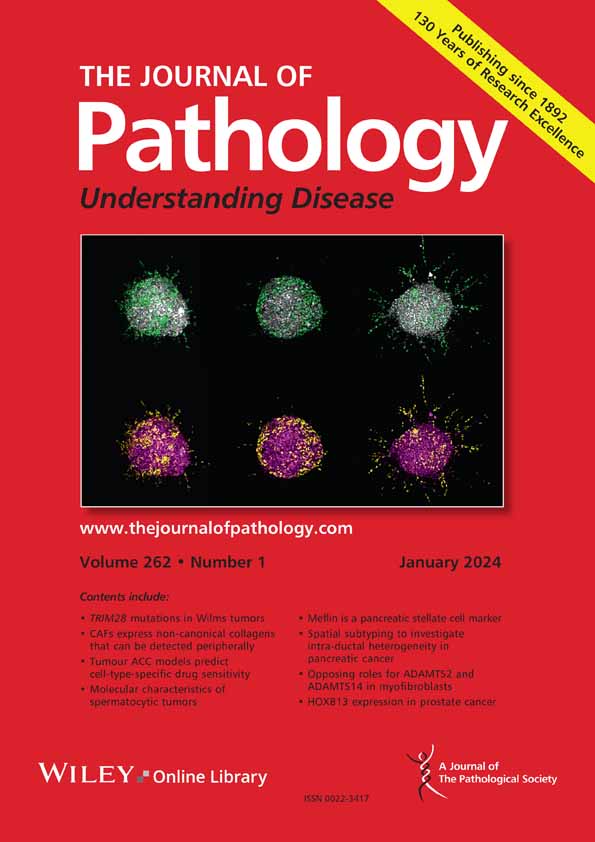求助PDF
{"title":"Sparking malignancy: nicotine as a driver of stemness and metastasis in triple-negative breast cancer<sup>†</sup>.","authors":"Christopher Simpkins, Eneda Toska","doi":"10.1002/path.6475","DOIUrl":null,"url":null,"abstract":"<p><p>Triple-negative breast cancer (TNBC) lacks expression of estrogen receptor (ER), progesterone receptor (PR), and HER2, and remains one of the most aggressive and therapeutically challenging breast cancer subtypes, marked by early relapse, metastasis, and limited targeted treatment options. In a recent study published in The Journal of Pathology, Kuo et al provide compelling evidence that nicotine exposure, whether from tobacco smoke or e-cigarette vapor, drives TNBC progression by promoting stem-like and metastatic phenotypes. Integrating clinical datasets, patient tissues, cell lines, and in vivo models, the authors demonstrate that nicotine enhances tumor aggressiveness via coordinated upregulation of CHRNA9 and IGF1R. Silencing either receptor attenuates nicotine-induced stemness, invasion, and metastasis, revealing a therapeutically actionable axis. High expression of CHRNA9 and IGF1R correlates with poor clinical outcomes and may define a nicotine-exposed TNBC subgroup that could benefit from IGF1R-targeted therapy or repurposed nicotinic receptor antagonists. These findings underscore the role of environmental exposures in shaping tumor biology and offer a mechanistic basis for the poorer prognosis observed in smokers with breast cancer. © 2025 The Pathological Society of Great Britain and Ireland.</p>","PeriodicalId":232,"journal":{"name":"The Journal of Pathology","volume":" ","pages":""},"PeriodicalIF":5.2000,"publicationDate":"2025-09-09","publicationTypes":"Journal Article","fieldsOfStudy":null,"isOpenAccess":false,"openAccessPdf":"","citationCount":"0","resultStr":null,"platform":"Semanticscholar","paperid":null,"PeriodicalName":"The Journal of Pathology","FirstCategoryId":"3","ListUrlMain":"https://doi.org/10.1002/path.6475","RegionNum":2,"RegionCategory":"医学","ArticlePicture":[],"TitleCN":null,"AbstractTextCN":null,"PMCID":null,"EPubDate":"","PubModel":"","JCR":"Q1","JCRName":"ONCOLOGY","Score":null,"Total":0}
引用次数: 0
引用
批量引用
Abstract
Triple-negative breast cancer (TNBC) lacks expression of estrogen receptor (ER), progesterone receptor (PR), and HER2, and remains one of the most aggressive and therapeutically challenging breast cancer subtypes, marked by early relapse, metastasis, and limited targeted treatment options. In a recent study published in The Journal of Pathology, Kuo et al provide compelling evidence that nicotine exposure, whether from tobacco smoke or e-cigarette vapor, drives TNBC progression by promoting stem-like and metastatic phenotypes. Integrating clinical datasets, patient tissues, cell lines, and in vivo models, the authors demonstrate that nicotine enhances tumor aggressiveness via coordinated upregulation of CHRNA9 and IGF1R. Silencing either receptor attenuates nicotine-induced stemness, invasion, and metastasis, revealing a therapeutically actionable axis. High expression of CHRNA9 and IGF1R correlates with poor clinical outcomes and may define a nicotine-exposed TNBC subgroup that could benefit from IGF1R-targeted therapy or repurposed nicotinic receptor antagonists. These findings underscore the role of environmental exposures in shaping tumor biology and offer a mechanistic basis for the poorer prognosis observed in smokers with breast cancer. © 2025 The Pathological Society of Great Britain and Ireland.
引发恶性肿瘤:尼古丁在三阴性乳腺癌的发生和转移中的驱动作用
三阴性乳腺癌(TNBC)缺乏雌激素受体(ER)、孕激素受体(PR)和HER2的表达,仍然是最具侵袭性和治疗挑战性的乳腺癌亚型之一,其特点是早期复发、转移和有限的靶向治疗选择。在最近发表在《病理学杂志》上的一项研究中,Kuo等人提供了令人信服的证据,证明尼古丁暴露,无论是来自烟草烟雾还是电子烟蒸汽,都通过促进茎样和转移性表型来驱动TNBC的进展。综合临床数据集、患者组织、细胞系和体内模型,作者证明尼古丁通过协调上调CHRNA9和IGF1R来增强肿瘤的侵袭性。沉默任一受体减弱尼古丁诱导的干性、侵袭和转移,揭示出治疗上可行的轴。CHRNA9和IGF1R的高表达与不良的临床结果相关,并可能定义尼古丁暴露的TNBC亚组,该亚组可能受益于IGF1R靶向治疗或重新用途的尼古丁受体拮抗剂。这些发现强调了环境暴露在形成肿瘤生物学中的作用,并为吸烟乳腺癌患者预后较差提供了机制基础。©2025英国和爱尔兰病理学会。
本文章由计算机程序翻译,如有差异,请以英文原文为准。

 求助内容:
求助内容: 应助结果提醒方式:
应助结果提醒方式:


